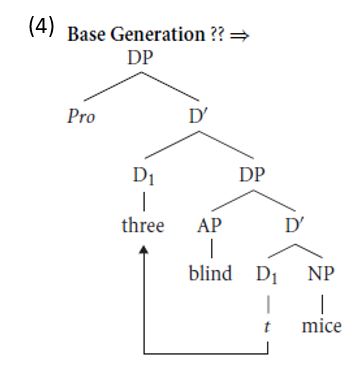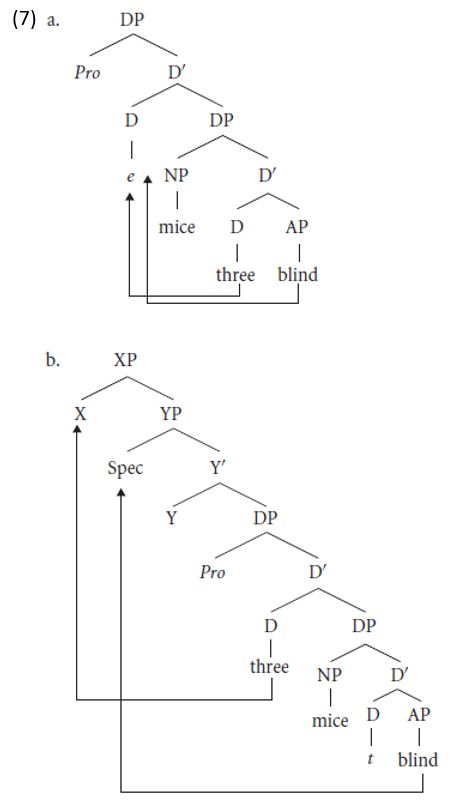


 Grammar
Grammar
 Tenses
Tenses
 Present
Present
 Past
Past
 Future
Future
 Parts Of Speech
Parts Of Speech
 Nouns
Nouns
 Verbs
Verbs
 Adverbs
Adverbs
 Adjectives
Adjectives
 Pronouns
Pronouns
 Pre Position
Pre Position
 Preposition by function
Preposition by function 
 Preposition by construction
Preposition by construction
 Conjunctions
Conjunctions
 Interjections
Interjections
 Grammar Rules
Grammar Rules
 Linguistics
Linguistics
 Semantics
Semantics
 Pragmatics
Pragmatics
 Reading Comprehension
Reading Comprehension|
Read More
Date: 1-3-2022
Date: 2024-01-19
Date: 6-1-2022
|
The problem of prenominal modifiers
The view sketched above can be extended to other postnominal modifiers including PPs, as in (1a), reduced relative clauses, as in (1b), and combinations of them as in (1c). The latter involve recursive DP shells and multiple raising to light heads, as shown in (2).


But what about prenominal modifiers, APs like those in (3), which are semantically equivalent to copular relative clauses? 1

One possibility is base generation along the lines in (4).

On reflection, however, this idea is problematic. Given a Ë-role-based approach, in order to project AP in the site shown in (4), we would apparently have to allow for an optional oblique Ë-role between two obligatory roles in our hierarchy, as in (5).

Worse yet, given the wide range of modifiers available in the prenominal site, we would seem to have to allow for a very large number of optional oblique Ë-roles between our two obligatory ones (6). This looks unpromising.

The only plausible alternative we see is that prenominal position is not a base position for adjectives in English, but rather a derived one. That is, we are led to resurrect the view of early transformationalists: that intersective attributive APs originate in the position of RCs, and obtain their surface position by movement, along the lines shown in either (7a) or (7b).

However, this raises the natural question as to why restrictive adjectives must move from their base position. Why can’t they remain in postnominal position like PPs, finite and reduced relative clauses?
1 We are not suggesting, of course, that all prenominal modifiers are equivalent to relative clauses. In fact there are well-known differences between them. For more on this topic see Larson (1998) and Larson and Takahashi (2007).
|
|
|
|
دخلت غرفة فنسيت ماذا تريد من داخلها.. خبير يفسر الحالة
|
|
|
|
|
|
|
ثورة طبية.. ابتكار أصغر جهاز لتنظيم ضربات القلب في العالم
|
|
|
|
|
|
|
سماحة السيد الصافي يؤكد ضرورة تعريف المجتمعات بأهمية مبادئ أهل البيت (عليهم السلام) في إيجاد حلول للمشاكل الاجتماعية
|
|
|